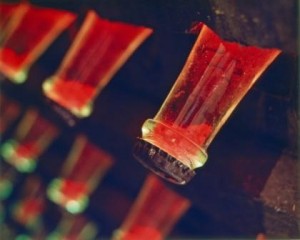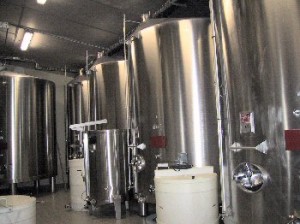
Let’s take a “white” Champagne made from 100% Chardonnay.
As explained in more detail in the the “Making Red and White Still Wine” section, Champagne starts out as ordinary “still” wine – the grapes are crushed and de-stemmed, and the juice is pressed from them and placed in a big vat called a fermenter. Some yeast is added, and the yeast turns the grape sugars to alcohol – and creates some carbon dioxide, which is allowed to escape. That’s called the base wine, and at this point it’s just “ordinary” Chardonnay.
But we don’t leave things alone. We now bottle that wine using a larger, thicker glass bottle with a unique shape. And we fill it with our base wine, but leave a little space in the neck. Then we add a little solution of sweet, unfermented grape juice and a tiny bit more yeast. The yeast goes to town on the sugar once again, but since the bottle is closed (using a temporary metal cap like a soda bottle) the Carbon Dioxide can’t escape. The bottle sits around for awhile, sometimes months, and instead of being bored or watching Oprah, the yeast is busy interacting with the wine and making it more complex and interesting.

When the winemaker says it’s time, the yeast is collected in the neck of the bottle, chilled using a special machine, and finally shot out, leaving crystal clear wine with all that carbon dioxide dissolved into it. The wine is now really bone dry-having turned all the sugar into alcohol-so to take the edge off a little more of that sweet grape juice is added back, and then it’s corked and that little wire cage is added to keep the good stuff secure inside. Now it’s your daughter’s first birthday, and while she’s busy covering herself with cream frosting, you pop that cork and this lovely wine comes forth, with all those pent-up bubbles now freed in your glass.
Here are some important wine terms related to Champagne:
Blanc de Blancs is white Champagne made from 100% Chardonnay.
Blancs de Noirs is white Champagne made from Pinot Noir and sometime Pinot Meunier grapes. There’s little or no color from those red grapes, though, because the juice is gently pressed and then fermented with no skin contact. Sometimes you’ll see a slight hint of gray or pink in these wines.
Champagne Effect is the heady, romantic feel you get when drinking this great stuff, and there’s a very scientific, non-romantic reason for it, explained here.
Grower Champagnes are wines made by typically very small houses, producers that bottle relatively tiny amounts, say, 2000 cases a year. They grow their own grapes in vineyards that they own, and while they’re usually very high quality, you’ve probably never tasted or even heard of them. Typically a bottle of Grower Champagne will have RM – “Recoltant-Manipulant” somewhere on the label, which roughly translated means “Grower-Winemaker.”
Methode Champenoise. A term that describes the way Champagne is made, which was generally applied in the past – and found on bottles of – sparkling wine made in places other than the Champagne region of France. The Champenois (people who live and work there) didn’t like anyone else using this term, either, so you’ll usually see “Methode Traditionelle” on the label of those bottles today.
Mono-cru Champagne means the wine was made from grapes pulled from a single, named vineyard. Many grower Champagnes are also mono-cru.
Rose Champagne is a pinkish-colored sparking wine made in one of two ways – either some red wine, generally Pinot Noir is added to white Champage, or less typically, the skins of some pressed Pinot Noir and/or Pino Meunier are left with the juice to extract just a bit of color and flavor.
Sparkling Wine is wine typically made in the style of Champagne, but not from grapes grown there. Some producers such as California’s Korbel refer to their wine as Champagne but it can’t be, by definition. And recent agreements that the US is part of will make it illegal for US producers to call their wine Champagne in the future. So, for example, the house of Moet & Chandon produces Champagne in France, but its US operation produces “California Sparkling Wine” in Napa under the label Chandon.
Vintage Champagne means that the wine was made from grapes from one or more vineyards but from a single year’s harvest. Vintage Champagnes don’t happen every year, but only in years when the crop is deemed to be excellent and then the vintage is formally “declared.”

Recent Comments